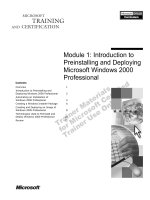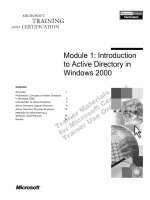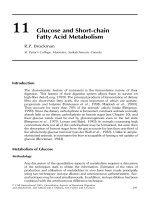Tài liệu Ethical Hacking Techniques to Audit and Secure Web-enabled Applications pptx
Bạn đang xem bản rút gọn của tài liệu. Xem và tải ngay bản đầy đủ của tài liệu tại đây (52.75 KB, 5 trang )
Sanctum Inc. 2002
www.SanctumInc.com
Ethical Hacking Techniques to Audit and Secure Web-enabled Applications
As public and private organizations migrate more of their critical functions to the Internet,
criminals have more opportunity and incentive to gain access to sensitive information through the
Web application. Gartner Group estimates that 75 percent of Web site hacks that occur today
happen at the application level and this number is expected to increase. Hackers target the web
application because it easily provides access to the most valuable business assets, such as
employee and customer data (like health records and credit card information) as well as
corporate proprietary information. While most web sites are heavily secured at the network level
with firewalls and encryption tools, these sites still allow hackers complete access to the
enterprise through web application manipulation.
Attackers break into the web application by thinking like a programmer: identifying how the
application is intended to work and determining shortcuts used to build the application. The
hacker then attempts to interact with the application and its surrounding infrastructure in malicious
ways simply by using the web browser or any of a large number of automatic hacker tools, such
as CGI scanners and HTTP proxys.
Understanding the techniques hackers use to manipulate Web applications and steal credit card
data, falsify financial transactions or access proprietary information, is the first step in learning
how to secure the Web application. This article will explain why the Web application is so
vulnerable to attack and discuss three of the most common Web application hacking techniques
and detail how to protect against these attacks and protect your mission critical information.
What is a Web Application?
The first important question is “What is a Web application”? Although most people have an
intuitive notion of what comprises a Web-enabled application, rarely do we think about its scope
and complexity. Web applications are typically multi-layered entities that include code and data
residing in many places within the enterprise (see Figure 1) that can be accessed directly or
indirectly from the Internet. Some parts of the application are typically developed in house are
unique to the enterprise while others are purchased from an external vendor (e.g. web servers,
databases, etc.) and are common for multiple enterprises. Vulnerabilities in any of the layers of
the web application will ultimately lead to a security breach of the whole application.
Sanctum Inc. 2002
www.SanctumInc.com
Three Common Web Application Vulnerabilities and How to Fix Them
Sanctum’s auditors have performed over 300 audits and proof of concepts over the last 3 years
and have found that 97% of the assessed sites had substantial vulnerabilities. While the most
effective way to assess web applications is by using an automated assessment tool, the three
common vulnerabilities explained below can be determined and mitigated manually.
Most examples will be presented in PHP for simplicity but apply equally to all the other languages
used for the front end such as Java and Perl and backend such as C, C++ and even Cobol.
1. Hidden Field Manipulation — Hidden fields are embedded within HTML forms to
maintain values that will be sent back to the server. Such hidden fields serve as a mean
for the web application to pass information between different parts of one application or
between different applications. Using this method, an application may pass the data
without saving it to a common backend system (typically a database). However, a major
assumption about hidden fields is that since they’re non-visible (i.e. hidden) they will not
be viewed or changed by the client. Web attacks challenge this assumption by examining
the HTML code of the page and changing the request (usually a POST request) going to
the server. By changing the value the entire logic between the different application parts,
the application is damaged and manipulated to the new value. Example 2 shows an
online shopping cart using a hidden field to pass the pricing information between the
order processing system and the order fulfillment system. If the application does not use
a backend mechanism to verify the flow of pricing information then altering the price will
lead to the ability to buy product for smaller amounts and potentially even negative sums.
Hidden Field Manipulation Fix: Hidden field values should only be used for client display
functionality. These parameters should never be used for server-side processing. Instead,
such data should be stored on the server (for example in a database) and retrieved upon
request.
Example 2: Hidden field manipulation
Original form
<form action=" method="POST">
<input type="hidden" name="price" value="99.99">
</form>
Correct request
POST /shop.pl HTTP/1.0
price=99.99
Attack Attempt
POST /shop.pl HTTP/1.0
price=0.99
Sanctum Inc. 2002
www.SanctumInc.com
2. Application Buffer Overflow — Web applications that receive parameters are typically
limited in the number of characters for both the name of the parameters and their values.
By sending long parameters or values it is possible to achieve a memory corruption in the
application, which can result in the application shutting down or the ability to gain high
privileges on the server machine. Example 3 shows a field that is limited in size.
However, by changing the form it is possible to put more characters into the parameter
causing the application to crash upon receiving the input. Of course, it is also possible to
create the outgoing request without changing the form itself.
See also:
Application Buffer Overflow Fix: Check every incoming parameter value to ensure that
it does not exceed the "maxsize" value set on the server for that specific parameter.
Example 3: Application buffer overflow
Original form
<form name="login" action=" />method="POST">
…
<input type="text" name="name" maxsize="30">
…
</form>
Correct request
POST /login.pl HTTP/1.0
…
name=izhar
Altered form
<form name="login" action=" />method="POST">
…
<input type="text" name="name" maxsize="10000">
…
</form>
Attack Attempt
POST /login.pl HTTP/1.0
…
name=0000000000000000000000000000000000000000000000000000000000000000
000000000000000000000000000000000000000000000000000000000000000000000
0000000000000000000000000000000000000000000000000000000000000000000
Sanctum Inc. 2002
www.SanctumInc.com
3. Cross-Site Scripting — A link to a valid web site can be manipulated so that one of the
parameters of the URL or maybe even the referrer will hold a script. This script will then
be implanted by the server into a dynamic web page and will run on the client side. The
script can then perform a “virtual hijacking” of the user’s session and can capture
information transferred between the user and the legitimate web application. The user
activates the malicious link when he crawls through a 3
rd
party site or by receiving an
email with the link in a web enabled email client. Example 4 shows JavaScript embedded
as the value of one of the parameters of the login page. Once the link is pressed, the evil
JavaScript residing on the third party site is activated and has full control over the client’s
browser.
See also:
/>
Cross-Site Scripting Fix: Limit undesired tags in dynamically generated pages and restrict
variables used in the construction of pages to characters explicitly allowed. Also, check these
variables during the generation of the output page.
Example 4: Cross-site scripting
Correct request
POST /login.pl HTTP/1.0
…
title=Home%20Page
Attack attempt
POST /login.pl HTTP/1.0
…
title=<script src=’ />
Function
function display_title()
{
global $title;
print “<B>Document $title</B>”;
…
}
Result of correct request
Home Page is displayed to the client
Result of attack attempt
Evil Script is running on the client
Sanctum Inc. 2002
www.SanctumInc.com
Conclusion
Most Web application vulnerabilities rely on a hacker’s ability to input invalid data or malicious
code into the application using techniques such as the ones described. For developers with time-
to-market deadlines, it is virtually impossible to comb through code and test every possible
permutation of a malicious technique a hacker may attempt. Fortunately, automated tools are
available to transcend human error and perform automatic vulnerability assessment on Web
applications by attempting every possible hacker attack and reporting the success of the attack
and the severity of the vulnerability. With Carnegie Mellon’s CERT Coordination Center reporting
over 52,658 cybersecurity incident in 2001, whether you chose to address this serious
vulnerability manually or automatically, protect your corporations vital assets, by making Web
application security a top priority.
Additional Resources
/> - CERT® Coordination Center
/> - System Administration, Networking, and Security Institute
/> - Open Web Application Security Project
/> - Contains the BUGTRAQ mailing list of vulnerabilities.
/> - Automatic tools for web application security.









